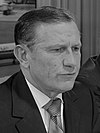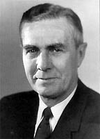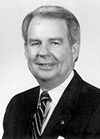

 | |
| Agency overview | |
|---|---|
| Formed | April 1, 1967; 57 years ago (1967-04-01) |
| Preceding agency |
|
| Jurisdiction | Federal government of the United States |
| Headquarters | Washington, D.C. |
| Annual budget | $46 billion (FY2019)[1] |
| Agency executives |
|
| Parent agency | Department of Transportation |
| Website | www |
The Federal Highway Administration (FHWA) is a division of the United States Department of Transportation that specializes in highway transportation. The agency's major activities are grouped into two programs, the Federal-aid Highway Program and the Federal Lands Highway Program. Its role had previously been performed by the Office of Road Inquiry, Office of Public Roads and the Bureau of Public Roads.
With the coming of the bicycle in the 1890s, interest grew regarding the improvement of streets and roads in America. The traditional method of putting the burden on maintaining roads on local landowners was increasingly inadequate. In 1893, the federal Office of Road Inquiry (ORI) was founded; in 1905, it was renamed the Office of Public Roads (OPR) and made a division of the United States Department of Agriculture.
Demands grew for local and state government to take charge. With the coming of the automobile, urgent efforts were made to upgrade and modernize dirt roads designed for horse-drawn wagon traffic. In 1910, the American Association for Highway Improvement was organized. Funding came from automobile registration, and taxes on motor fuels, as well as state aid. By 1914, there were 2.4 million miles of rural dirt rural roads; 100,000 miles had been improved with grading and gravel, and 3,000 miles were given high-quality surfacing. The rapidly increasing speed of automobiles, and especially trucks, made maintenance and repair high-priority items.
In 1915, OPR's name was changed to the Bureau of Public Roads. The following year, federal aid was first made available to improve post roads and promote general commerce: $75 million over five years, issued through the BPR in cooperation with the state highway departments.[2][3]
In 1939, BPR was renamed to the Public Roads Administration (PRA) and shifted to the Federal Works Agency. After the FWA was abolished in 1949, the organization was once again named the Bureau of Public Roads; it was placed under the Department of Commerce.[4]
From 1917 through 1941, 261,000 miles of highways were built with $3.17 billion in federal aid and $2.14 billion in state and local funds.[a]
The Federal Highway Administration was created on October 15, 1966, along with the Bureau of Motor Carrier Safety and the National Highway Safety Bureau (now known as National Highway Traffic Safety Administration), as part of the new U.S. Department of Transportation.[6] The FHWA took over the functions of the Bureau of Public Roads the following year.
The FHWA's role in the Federal-aid Highway Program is to oversee federal funds to build and maintain the National Highway System (primarily Interstate highways, U.S. highways and most state highways). This funding mostly comes from the federal gasoline tax and mostly goes to state departments of transportation.[7] The FHWA oversees projects using these funds to ensure that federal requirements for project eligibility, contract administration and construction standards are adhered to.
Under the Federal Lands Highway Program (sometimes called "direct fed"), the FHWA provides highway design and construction services for various federal land-management agencies, such as the Forest Service and the National Park Service.
In addition to these programs, the FHWA performs and sponsors research in the areas of roadway safety, congestion, highway materials and construction methods, and provides funding to local technical assistance program centers to disseminate research results to local highway agencies.
The FHWA also publishes the Manual on Uniform Traffic Control Devices (MUTCD), which is used by most highway agencies in the United States. The MUTCD provides such standards as the size, color and height of traffic signs, traffic signals and road surface markings.
Long-Term Pavement Performance (LTPP) is a program supported by the FHWA to collect and analyse road data. The LTPP program was initiated by the Transportation Research Board (TRB) of the National Research Council (NRC) in the early 1980s. The FHWA with the cooperation of the American Association of State Highway and Transportation Officials (AASHTO) sponsored the program. As a result of this program, the FHWA has collected a huge database of road performance. The FHWA and the ASCE hold an annual contest known as LTPP International Data Analysis Contest, which is based on challenging researchers to answer a question based on the LTPP data.[8]
In 2010, FHWA launched the Every Day Counts (EDC) initiative to identify and deploy innovations to reduce project delivery time, enhance safety, and protect the environment.[9][10][11][12] EDC is a state-based model that rapidly deploys proven, yet underutilized innovations. FHWA works with State transportation departments, local governments, tribes, private industry, and other stakeholders to identify a new collection of innovations to champion every two years that merit accelerated deployment. Among the approaches promoted by the EDC effort are: adaptive traffic control to reduce fuel consumption and improve travel time reliability; alternative intersection design; prefabricated bridge elements and systems; high-friction surface treatments; warm mix asphalt; ultra-high-performance concrete; virtual public involvement; and time-saving strategies such as rapid bridge replacement.[13] Since the inception of EDC, each state has used 26 or more of the 57 innovations and some states have deployed more than 45. Many of these practices have become mainstream practices across the country.[14]
The Federal Highway Administration is overseen by an administrator appointed by the President of the United States by and with the consent of the United States Senate. The administrator works under the direction of the Secretary of Transportation and Deputy Secretary of Transportation. The internal organization of the FHWA is as follows:[15]
| Portrait | Administrator | Term started | Term ended |
|---|---|---|---|

|
Roy Stone | October 3, 1893 | October 13, 1899 |

|
Martin Dodge | January 31, 1899 | 1905 |

|
Logan Waller Page | 1905 | December 9, 1918 |

|
Thomas Harris MacDonald | April 1, 1919 | March 31, 1953 |

|
Francis Victor du Pont | April 1, 1953 | January 14, 1955 |

|
Charles Dwight Curtiss | January 14, 1955 | October 1956 |

|
John A. Volpe | October 22, 1956 | February 5, 1957 |

|
Bertram D. Tallamy | February 5, 1957 | January 20, 1961 |

|
Rex Marion Whitton | January 20, 1961 | December 30, 1966 |

|
Lowell K. Bridwell | March 23, 1967 | January 20, 1969 |

|
Francis Turner | March 13, 1969 | June 30, 1972 |

|
Ralph Bartelsmeyer (acting) | July 1, 1972 | June 1, 1973[16] |

|
Norbert Tiemann | June 1, 1973 | March 31, 1977 |

|
William M. Cox | April 7, 1977 | May 1, 1978 |

|
Karl S. Bowers | April 3, 1978 | January 1980 |

|
John S. Hassell Jr. | July 11, 1980 | February 5, 1981 |

|
Ray Barnhart | February 12, 1981 | December 31, 1987 |

|
Robert E. Farris | June 8, 1988 | May 17, 1989 |

|
Thomas D. Larson | August 10, 1989 | January 20, 1993 |

|
Rodney E. Slater | June 3, 1993 | February 14, 1997 |

|
Kenneth R. Wykle | December 2, 1997 | September 4, 2001 |

|
Mary E. Peters | October 2, 2001 | July 29, 2005 |

|
J. Richard Capka | May 31, 2006 | January 24, 2008 |

|
Thomas J. Madison Jr. | August 18, 2008 | January 20, 2009 |

|
Victor Mendez | January 20, 2009 | July 24, 2014 |

|
Gregory G. Nadeau | July 30, 2014 | January 20, 2017 |

|
Brandye Hendrickson (acting) | July 24, 2017 | May 6, 2019 |

|
Nicole Nason | May 7, 2019 | January 20, 2021 |

|
Stephanie Pollack (acting) | February 24, 2021[17] | January 13, 2023 |

|
Shailen Bhatt | January 13, 2023 | Incumbent |
|
| ||
|---|---|---|
| ||
| Deputy Secretary of Transportation |
|
|
| Under Secretary of Transportation for Policy |
| |